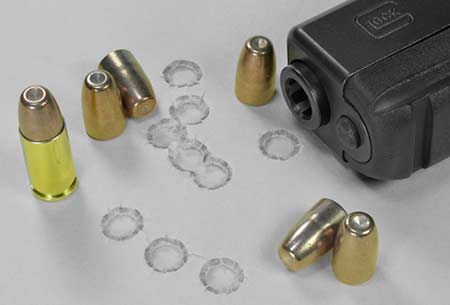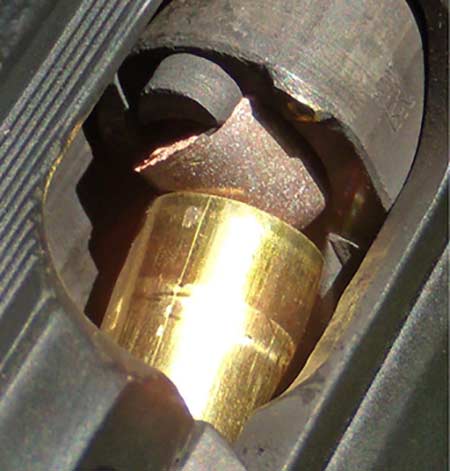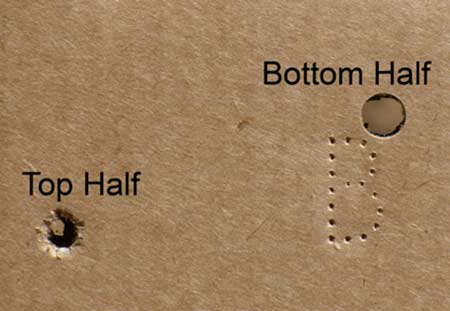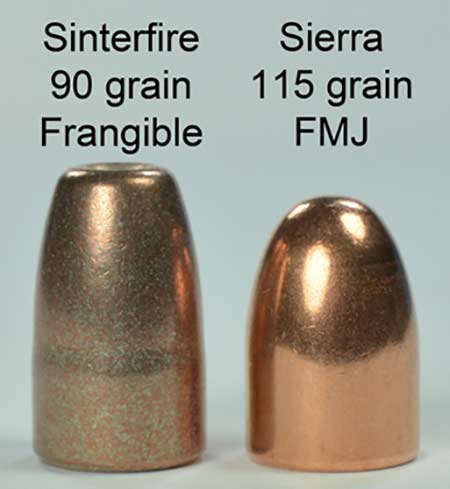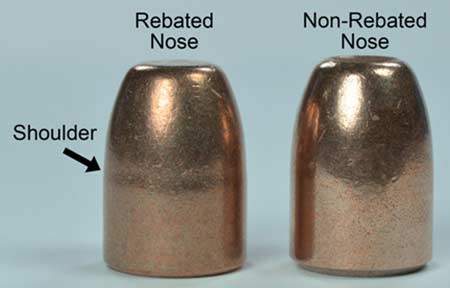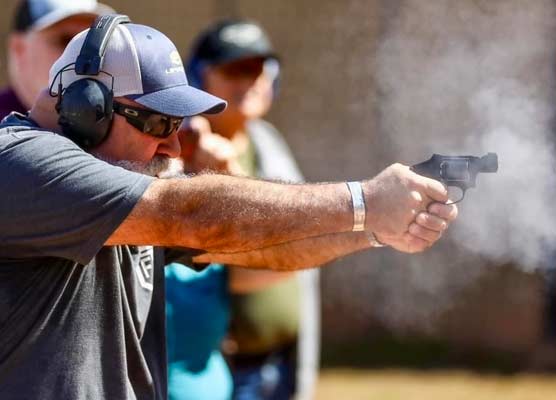Handloading Lead-Free Frangible Bullets For Pistols
Get The Facts On These Powdered Metal Wonders!
Frangible bullets are unique. They’re lead-free and made of powdered metal such as copper, tin, tungsten, zinc, bismuth, iron, steel and polymer. The most common element is powdered copper. The powdered material is compressed into the desired shape.
Frangible bullets are hard and brittle by design. They’re intended to disintegrate into powder (their original form) on impact, when encountering something harder than itself. This design is ideal for use on steel targets since they produce smaller fragments than lead-based bullets, making them safer to use on steel. Frangible bullets should not be confused with “pre-fragmented” bullets like the Glaser Safety Slug, which perform differently.
Splash-back and ricochet from lead bullets is not trivial in many cases. The dense nature of lead and tough copper jackets means fragments tend to be large and retain considerable force for quite a distance. Many shooters have been bloodied and bruised — and worse — by bullet fragments shot at steel, and they pose a real hazard with every round you fire, not only to the shooter, but to bystanders as well.
I’ve been hit countless times by my own, and others’ lead bullet fragments when shooting steel targets. Blood was drawn on many occasions, including a trip to the emergency room to remove a ricocheted .22 bullet from my wrist.
Another one of the more dangerous hits I’ve received was when I was a range officer watching a shooter during a USPSA match. During the shoot, the entire, flattened jacket from the shooter’s JHP bullet bounced off a steel plate and hit me in the shoulder, cutting through two heavy shirts and my skin. It hurt, like getting punched, and left a bruise the size of a baseball.
Once I got a painful whack from a bullet fragment while I was walking to the clubhouse during a national competition. The steel targets were at least 75 yards away — and that impact was from a pistol round. Another competitor at that match ended up in the hospital overnight after taking a jacket fragment deep in the hand.
Frangible bullets can be handloaded just like standard bullets, but with some caveats.
Frangible bullets are made from powdered metal and pulverize into small fragments when they hit steel or other hard objects, reducing ricochet hazards. Lead and jacketed bullets produce large fragments when hitting the same objects and produce dangerous ricochets.
Not Fragment-Free Though
It’s safe to say, frangible bullets greatly reduce the splash-back and ricochet hazard. They are not immune from producing fragments, but they are smaller and less dense than those from lead bullets. This does not mean frangible bullets are only good for shooting steel targets. They’re excellent projectiles for all types of shooting and are often even available in self-defense loads.
There are benefits to frangible bullets other than just reducing ricochet hazards, and these include reduced airborne lead. Combined with lead-free primers, they make totally lead-free ammunition with no risk of airborne lead particles. This makes them especially good to keep down lead contamination at indoor shooting ranges. The interest in lead-free projectiles with respect to environmental concerns is another advantage.
Many ammunition manufacturers offer frangible loads of some sort, and this includes handgun, rifle and shotgun ammunition. For instance, Sinterfire, Polycase and ICC Ammo specialize in frangible ammunition.
Frangible bullets are also available to handloaders, including projectiles for handguns, rifles and shotguns. Sinterfire and CTX are the most commonly known. Sinterfire has been making frangible bullets since 1998, and are used in their own ammunition as well as by other manufacturers, such as Fiocchi and Team Never Quits. CTX frangible bullets, made by Continuous Metal Technology, have been made since the mid-1990’s, and are loaded in ICC factory ammunition. Both Sinterfire and CTX bullets are made with a copper-tin mixture. At this time, Polycase only offers .458 SOCOM bullets.
Not how one bullet broke cleanly when stressed by a too-strong crimp force.
A spectacular feeding jam caused by a broken frangible bullet.
Reloads?
Handloading frangible bullets requires special attention. Their hard, brittle nature means you must take extra care to avoid damaging the bullet during the loading process. The critical step is crimping. If too much crimp is applied, the bullets can crack or break off. In some instances, the damage is obvious and the tip of the bullet will simply fall off.
Sometimes the broken bullet is not discovered during the reloading process and does not show up until the round feeds or fires. If the nose breaks off during feeding it can produce a unique feeding failure as shown in the photo. In this case, the nose detached and caused a jam.
In other instances the cracked bullet will feed and fire, but the broken bullet will separate during flight and produce multiple holes in the paper with the single shot. The accompanying picture show two holes produced with a single shot because of that very failure. Presumably the bottom half of the bullet made the clean wadcutter-like hole.
It’s not difficult to get the crimp right, but it does require close attention. Some frangible bullets have a rebated nose designed to accept a slight taper crimp when seated to a proper overall length. Other frangible bullet designs lack the rebated nose, and can tolerate no crimp whatsoever. Care must be taken to only remove the flare from the case mouth when running the round through the crimp die. Even the slightest crimp can crack these bullets.
Two hits on target from a single shot. The frangible bullet separated mid-flight.
Use Caution
Frangible bullets are long for their weight, because they are not as dense as lead. This means when they’re seated to the same overall length as a lead bullet of the same weight, they reduce the internal space in the case. This raises pressure in handgun cartridges so the powder charge for frangible bullets must be reduced to keep pressures safe.
You also won’t get the same velocity from frangible bullets as you would from same-weight lead bullets in handguns. This isn’t all bad, because this translates into less recoil. Thus, they behave like heavy bullets but require less powder than what you would normally use for their weight.
Lower recoil is welcome, although some gunpowders, especially fast burning ones, might not produce enough recoil impulse to reliably cycle a semi-auto. I found medium burn-rate powders, even loaded below maximum charge weights, cycled my guns reliably with frangible bullets. Some loads using faster powders didn’t always cycle unless they were near their maximum charge.
Frangible bullets are long for their weight. Note how the 90-grain Sinterfire (left) is longer than the conventional lead/copper 115-grain FMJ Sierra.
The Remington bullet has a short nose and is designed for use in the .357 SIG.
Rifles
Rifle loading is a little different than loading for handgun cartridges. Perusing the Western Powders load data shows the frangible bullets can achieve the same velocity as their lead counterparts. I’ve not loaded frangible bullets for rifles, so I can’t say much about that. But if you’re going to do it, keep our talking points in mind as many may also apply to loading rifle bullets. Do your research first, then load!
Reloading data is available from Sinterfire, Frangible Bullets, Western Powders (Accurate, Ramshot) and Hodgdon at their websites. The load advice from Frangible Bullets (https://frangiblebullets.com/Reloading.html) is more general than specific, and indicates you use data typical of heavier lead bullets. For example, for their 100-grain 9mm Luger bullet they advise using data for a 135-grain lead-cored bullet. These resources, and an old load guide from West Coast Bullets, provided data for test loads in 9mm Luger, .357 SIG, .40 S&W and .45 Auto.
The best group for each caliber tested. 9mm: 90 grain Sinterfire with True Blue. .357 SIG: 100 grain Remington with Accurate #7. .40 S&W: 105 grain Sinterfire with Silhouette. .45 Auto: 145 grain Sinterfire with Winchester 231.
Load Data
The test guns were a Glock G19 9mm, a S&W M&P with a 4.88″ KKM Precision .357 SIG barrel, a Para Ordnance .40 S&W with an Ed Brown 5″ barrel, and a Para Ordnance .45 Automatic with a 5″ barrel.
A single 15-shot group was fired for accuracy at 25 yards from a Ransom Rest. Velocity was recorded with a Shooting Chrony chronograph at about 10 feet.
The 9mm was loaded with Winchester brass and CCI 500 primers. The .357 SIG loaded with Winchester or SIG brass and Winchester small pistol primers. The .40 S&W was loaded with Winchester brass and Winchester small pistol primers. The .45 Auto was loaded with Winchester brass and CCI 300 primers.
The accuracy with my pistols was average, to a bit less than average. None of the 15-shot groups were exceptional. Only one group measured under 3″. That was the with the .40 S&W, and that group measured 2.5″, which is pretty good for 15 rounds. The next smallest group was produced by the .357 SIG at 3.0″. The .45 Auto produced a majority of the groups under 4″. The smaller groups were encouraging enough to suggest they could improve with a little more testing.
Some basic bullet nomenclature
Factory Loads
For comparison, I also tried some factory Sinterfire 100 grain frangible ammunition. The factory load produced a 15-shot 5.4″ group from the Glock. My handloads with the same weight bullet produced the same size group or smaller — down to 4.6″. These group sizes are nothing special, but certainly qualify as “combat accurate” if you will.
These results do not mean frangible bullets cannot produce exceptional results, only that the loads I tested in my guns did not. Every gun — and barrel — is different and have preferences. Not all loads are equally accurate, and perhaps the ones I selected were not the best. As with any bullet, you must try different loads to see what your gun likes.
Frangible bullets are about the same price as better jacketed bullets. If you shoot steel targets, these are the ideal bullets, and their extra margin of safety easily justifies their cost. They’re also the choice for the environmentally conscious shooter, and of course, any range or location where lead is not allowed.

